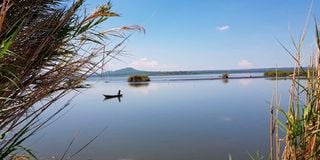Fishermen abandon trade as fish dwindles in Lake Kanyaboli

Lake Kanyaboli is the largest oxbow lake in Kenya and the second largest in Africa.
What you need to know:
- Fish population has reduced drastically in Africa's second-largest oxbow lake.
- Nyalaji beach has been abandoned, with very few fishing vessels on the shore.
Fishing business in Lake Kanyaboli, Siaya County, is slowly ebbing away with several fishermen opting for another source of income to meet their daily needs.
This is due to a drastic reduction in the fish population in the second-largest oxbow lake in Africa.
Gone are the days when boats would be filled with fish every evening when the fishermen docked from a day’s hustle.
“There is no fish. The few that are there can’t satisfy the demands of the local market. Venturing into fishing in this lake today is sheer luck because on several occasions fishermen return without a proper catch,” says Mr Erick Owino from Nyalaji Beach Management Unit (BMU).
A visit to Nyalaji beach shows an abandoned area with very few fishing vessels on the shore; some are vandalised while others are slowly rotting away.
The dwindling fish catch has forced most of the fishermen to abandon the trade and sell off their vessels.
“Some people went to Lake Victoria to try their luck there while others resorted to boda boda business,” explains Mr Owino.
Having been a fisherman in Lake Kanyaboli for over two decades, Mr Owino recalls the good old days when there were plenty of fish species in the lake.
“This lake had a rich variety of fish. Fishermen did not have a hard time. Getting 100kg of fish in a day was achievable, today, however, things have changed,” he laments.
The number of fishmongers who flocked the beaches to buy fish from the fishermen has also gone down.
Ms Moniza Atieno, 45, says getting fish from Kanyaboli is a nightmare because the commodity is scarce.
“There is only one type of fish that is currently available and that is ‘dwel’, (Singida tilapia), getting other species is sheer luck. And because there is high demand the fishermen hike the prices,” she said.
“Nyalaji, Ratuoro and Kadenge are the major markets for the fish from Kanyaboli. Due to the increased population of people, the fish is hardly enough. Some time back I used to sell fish in Siaya town; today it’s impossible because the stock has depleted.”
Mr Joseph Ochieng, an environmental conservationist and a scholar, attributes the depletion of fish to the collapse of a dyke.
“When the dyke burst last year, water gushed out for more than a week. So the fish that were breeding in the floating papyrus were carried away,” he says.
Mr Ochieng said the low stock is also as a result of failure to replenish the fish from the original water source — River Yala.
He said the fish has been in the lake for over 20 years ago when the swamp was reclaimed, and fishing has not stopped, therefore, the population has gone down.
He said that overfishing and the use of wrong fishing gear are the other potential causes of the reduced fish population.





